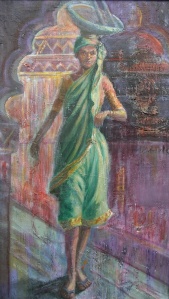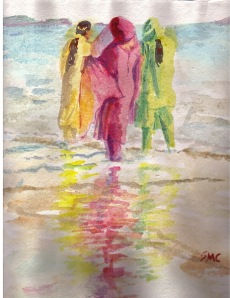My favourite subject is women. I especially like to paint hardworking women who look beautiful and elegant even when they are doing heavily-demanding physical labour. India provides the ideal environment for all these requirements to come together.
The women are slim, statuesque and very beautiful with dramatic eyes and dark luxuriant hair. Especially if they don’t smile. Why if they don’t smile, you ask? Because they are often the most poorly treated members of the family and are usually the last to eat in their households. The father eats first, then the sons in order of age. Little boys are often fed the choicest bits while their sisters merely look on. The daughters-in-law eat last. If there is any food left over that is what the women eat (hence their slimness). There is almost never enough money available to fix teeth.
I painted Everyday Workday (below) in Kerala, India. Here, I experimented with putting one figure atop the other. Women, except the most modern ones, wear their hair long and braided. In the south, they do not cover their heads.
Our train coming into Hubli station arrived late because (we found out later) there had been a bombing further up the track. I used my time during the long wait taking pictures of the women farmers who use the station’s crossover to bypass the tracks on their way to and from their rice fields. This painting is of one of these farmers with her sari skirt tucked up to allow her to work in the wet muddy field.
The culture still demands that women wear saris or salwar kameez, unlike in many developing countries where they have switched to Western dress. This makes for great photography and great paintings. Salwar kameez consist of a long overblouse made of lightweight fabric worn over harem-style pants. Part of the outfit is the duppata, a long wide scarf usually worn backwards and draped elegantly over the shoulders (or head) that modestly camouflages the breasts. Both the sari and the salwar are usually light, ethereal and colourful, and they often shimmer with gold or silver threads running thru the cloth or at the borders. These beautiful clothes are one of the reasons I come to India to paint. In my travelling clothes, I look very shabby and unkempt by comparison.
Above is a photo of porters in Googla. They were delivering heavy loads of wood for cooking fires. I followed them to their delivery site and took a number of photos before they put their loads down. Googla Woodcarrier (below) is a painting that resulted from these photos.
One time we were travelling on an overnight train. I got into a reasonably revealing conversation with a beautiful young woman traveling with her son. We talked of differences in culture, marriage and women’s lives. We compared women’s fashions. I asked her what she thought of the outfits she saw foreign women wearing (without specifically referring to what I had on: baggy cargo pants with lots of pockets, floppy hat to keep off the sun and a long, blousy and often-wrinkled top).
Her answer surprised me. She said, “you all look so comfortable and your clothes are so practical”. I said her salwar kameez was lovely and practical, too. She proceed to complain about the dupatta: how difficult it was to keep in place, always sliding off her shoulders or blowing off in the breeze. So I asked, “why don’t you stop wearing it”. She explained that her husband was old-fashioned and he would not think she was completely dressed if she omitted it. I was looking for elegance, she was admiring practically.
We stayed for over a week in a small shipbuilding port called Mandvi in Gujarat. Its beach was shallow causing great reflections. Since Indians in general don’t/can’t swim, I had the opportunity to take many photos of the women fully clothed wading in the water, casting fabulous, bright reflections.
I admire dark exotic elegance. As demonstrated by this dark-haired beauty at the Golden Temple in Amritsar, Indians admire children who are fair and blonde. Thus this little one sports a hat with fake ringlets attached.
We so often admire and covet what we don’t have, but I ask you: is the grass really greener?








